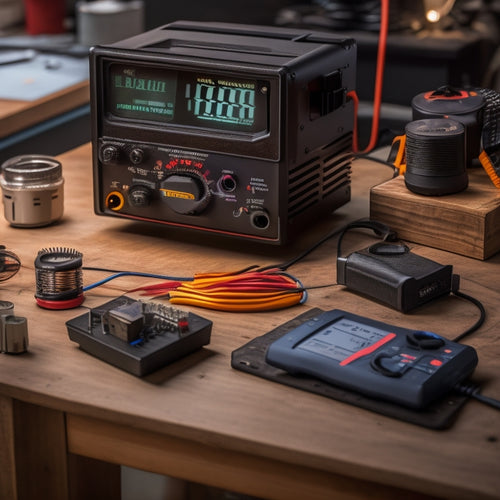
What's the Best Portable Water Purification System
Share
The best portable water purification system combines compact design with effective filtration technologies. Look for systems utilizing gravity filtration for larger particles and UV treatment for microorganisms. Weigh options based on your water source; rivers may need a sturdy filter while wells might require UV purification. User reviews emphasize systems that are lightweight and easy to transport, enhancing usability during outdoor excursions. Maintenance and ease of use are also vital; you want a system that doesn't complicate your experience. There's a range of options available, and exploring these can help you find the perfect fit for your needs.
At a Glance
- Assess the filtration capabilities of the system to ensure it targets specific contaminants present in your water source.
- Consider compact and lightweight designs for easy transport, especially for outdoor activities or travel.
- Look for systems with multiple purification methods, such as gravity filtration combined with UV treatment, for enhanced effectiveness.
- Check user reviews to gauge convenience, efficiency, and maintenance requirements of different portable purification systems.
- Ensure the system is compatible with your water source type and can effectively address potential contaminants.
Compact and Lightweight Design
A compact and lightweight design is essential for a portable water purification system, as it enhances usability and accessibility.
These systems are particularly beneficial for backpackers, as they often feature lightweight designs that cater to the need for portability.
You'll appreciate the space-saving features that allow for efficient storage and transport, making it easy to take on outdoor expeditions or emergencies.
Additionally, easy carry options guarantee that you can always have access to clean water, wherever you go.
Space-Saving Features
When considering portable water purification systems, the compact and lightweight design greatly enhances their usability. These products often showcase impressive space efficiency, allowing you to pack them without sacrificing room for other essentials.
Whether you're hiking, camping, or traveling, a smaller unit can fit easily into your backpack or luggage, providing travel convenience that larger systems simply can't match.
Many modern purification systems are engineered with innovative materials and designs, resulting in devices that aren't only easier to carry but also effective in purifying water.
Look for models that feature collapsible or modular designs, which can be stored in minimal space when not in use. This capability boosts your freedom to roam without being bogged down by bulky gear.
Additionally, these space-saving features often include integrated storage compartments for filters and accessories, further optimizing your packing strategy.
By prioritizing portability, you're not just choosing a purification system; you're choosing a lifestyle that welcomes exploration and spontaneity.
With a compact and lightweight design, you can guarantee that wherever you go, you'll always have access to clean water without compromising your travel experience.
Easy Carry Options
In the domain of portable water purification systems, easy carry options play an essential role in enhancing user experience. When you're planning outdoor escapades, you want a system that's not only effective but also lightweight and compact.
Travel-friendly options can remarkably reduce the bulk in your pack, allowing you to focus on enjoying your expedition rather than lugging around heavy gear.
Many of today's portable water purifiers feature designs that prioritize portability without sacrificing performance. Look for models made from durable yet lightweight materials, ensuring they can withstand the rigors of travel.
Systems that integrate multiple purification methods—such as filters and UV light—often come in compact sizes, making them easy to stow away in your backpack.
Additionally, consider options with built-in carry handles or straps, which enhance mobility during your outdoor excursions. Some products even come with their own carrying cases, adding to their convenience.
Ultimately, choosing a portable water purification system that emphasizes easy carry options means you can stay hydrated and safe, no matter where your escapades take you.
Healthier Drinking Water Access
Access to clean drinking water is essential for maintaining health and preventing disease.
Portable water purification systems, especially those utilizing UV-C technology, offer practical solutions for ensuring safe water in various environments, from remote areas to emergency situations.
Understanding their functionality and benefits can greatly enhance your ability to access healthier drinking water.
Importance of Clean Water
Clean water is fundamental for maintaining overall health and preventing disease. Access to clean drinking water directly impacts your well-being and quality of life. Waterborne diseases, caused by pathogens in contaminated water, can lead to severe health issues and even death. By ensuring you have access to purified water, you greatly reduce the risk of these illnesses.
Moreover, effective sanitation practices are essential in supporting clean water access. Proper disposal of waste and treatment of water sources can minimize contamination and promote healthier communities. When you prioritize clean water, you enable yourself and those around you to lead healthier lives.
The implications of clean water access extend beyond individual health; they touch on economic stability and social equity. Communities with reliable access to purified water can focus on development and growth rather than combating disease outbreaks and health crises.
Investing in portable water purification systems allows you to take control of your water quality, especially in emergency situations or remote areas.
Ultimately, understanding the importance of clean water is critical for safeguarding your health and enhancing your freedom to thrive in any environment.
Portable Solutions Overview
Portable water purification systems provide a practical solution for ensuring healthier drinking water access, especially in areas where traditional sources may be compromised. These systems vary widely in design and capability, allowing you to choose one that best fits your needs. From compact filters to UV purifiers, each option has its strengths and weaknesses.
User reviews often highlight the convenience of portability, making it easier for you to carry these systems on camping trips, hikes, or even in emergency situations. Many users appreciate the speed and efficiency of certain models, which can purify water in minutes.
However, user experiences also reveal that not all systems are created equal. Some may struggle with certain contaminants, while others excel in specific environments.
When selecting a portable water purification system, consider factors such as filtration capabilities, ease of use, and maintenance requirements. It's essential to read through user reviews to gauge real-world performance and reliability.
Key Purification Technologies Overview
When considering portable water purification systems, understanding the key technologies is essential.
Filtration methods, which physically remove contaminants, and chemical treatment options, which neutralize harmful substances, each play a significant role in ensuring water safety.
Additionally, just as battery water maintenance is important for peak performance, maintaining clean water sources is necessary for effective purification.
Filtration Methods Explained
Understanding the various filtration methods is vital for anyone looking to implement an effective water purification system. Among the most common methods are gravity filtration and ultraviolet purification.
Gravity filtration works by utilizing the natural force of gravity to pull water through a filter medium, effectively removing sediments and larger contaminants. This method is simple and requires no power source, making it ideal for outdoor enthusiasts and those in remote areas.
However, while it's effective for particulate matter, it may not eliminate pathogens unless combined with additional treatments.
Ultraviolet purification, on the other hand, uses UV light to disinfect water by destroying the DNA of bacteria, viruses, and other microorganisms. This method is efficient and requires minimal time, but it does need a power source, which can be a limitation in off-grid situations.
It's important to guarantee that the water is pre-filtered to remove turbidity, as cloudy water can hinder UV effectiveness.
Chemical Treatment Options
Chemical treatment options play an important role in ensuring water purity, especially in situations where physical filtration methods may fall short. These methods primarily involve the addition of chemicals that trigger specific chemical reactions, effectively neutralizing harmful pathogens and contaminants.
Chlorination is one of the most common techniques used, where chlorine compounds kill bacteria and viruses, enhancing purification effectiveness. However, it's vital to manage chlorine levels carefully, as excessive amounts can lead to harmful byproducts.
Another prevalent method is the use of iodine tablets, which also target microorganisms through similar chemical reactions. Iodine is particularly effective in treating clear water but may not be suitable for long-term use due to potential health concerns.
Additionally, you might consider using hydrogen peroxide, which oxidizes contaminants, making it a versatile option for various water sources.
While chemical treatments can greatly improve water safety, it's important to understand their limitations. They may not remove heavy metals or chemical pollutants, meaning combining these methods with filtration could provide a more comprehensive approach to water purification.
Ultimately, selecting the right chemical treatment depends on your specific needs and the contaminants present in the water.
Assess Your Water Source
Evaluating your water source is essential for effective purification. Start by identifying any contaminants that may be present, as this will directly influence your choice of purification method.
Additionally, consider the type of water source—whether it's a river, lake, or well—since different sources can introduce unique challenges.
Utilizing solar energy for water pumping can also enhance the quality of water, reducing the risk of waterborne diseases and ensuring a more reliable water supply for purification.
Identify Contaminants Present
How can you guarantee your water is safe to drink if you don't know what contaminants might be lurking in it? Identifying the specific contaminant types in your water source is essential for your health and well-being.
Water can harbor a variety of pollutants, including bacteria, viruses, heavy metals, and chemical runoff. Each of these poses different health risks, from gastrointestinal illnesses to long-term exposure effects that can compromise your immune system.
To effectively assess your water, start by testing it. You can use home testing kits or send samples to certified laboratories for a more thorough analysis. Look for indicators of common contaminants like E. coli, lead, and pesticides. Understanding the presence of these substances not only informs your purification methods but also enables you to make informed decisions regarding your health.
If you're relying on natural sources, like rivers or lakes, you might encounter additional risks, such as agricultural runoff or wildlife waste.
Consider Water Source Type
When considering the safety of your drinking water, the type of source you rely on plays an essential role in determining potential contaminants. Different sources, such as rivers, lakes, or wells, can introduce various pollutants, including bacteria, sediments, and chemicals. You need to assess your source before choosing a purification system.
For surface water, gravity filtration systems can be particularly effective. These systems employ the natural force of gravity to filter out larger particles and some microorganisms, providing a convenient method for purifying water during outdoor excursions. However, for deeper contaminants, you may need a more vigorous solution.
If you're relying on solar purification, be aware that this method can take longer to effectively eliminate pathogens. Solar purification employs UV radiation from sunlight, making it a sustainable option, but its efficiency hinges on weather conditions and exposure time.
Ultimately, understanding your water source helps you select the right purification system that suits your needs. Evaluate the contaminants likely present, and match them with an appropriate filtration solution to guarantee the safety of your drinking water wherever your journeys take you.
Superior Filtration Efficiency
When evaluating portable water purification systems, understanding the differences in filtration technology is essential.
Each method, whether it's activated carbon, reverse osmosis, or UV treatment, offers unique advantages and limitations.
Filtration Technology Comparison
While many filtration technologies claim to purify water effectively, not all methods deliver the same level of efficiency. When comparing filtration systems, two prominent technologies stand out: gravity filters and UV sterilization.
Gravity filters employ a natural process, relying on gravity to pull water through multiple filter layers. These filters can remove sediment, bacteria, and protozoa, offering an effective solution for many outdoor enthusiasts.
However, they may struggle with virus removal unless specifically designed to do so, which can limit their overall effectiveness in certain situations.
On the other hand, UV sterilization employs ultraviolet light to deactivate harmful microorganisms. This method is highly efficient at eliminating bacteria and viruses, making it a strong contender for portable water purification.
However, UV systems require a power source and clear water to function at peak performance, which can be a drawback in remote areas.
Ultimately, your choice depends on your specific needs. If you prioritize ease and immediate filtration, gravity filters may suit you.
However, if you're concerned about viruses and have access to power, UV sterilization could be your best bet. Understanding these technologies helps you make an informed decision for safe water access.
Frequently Asked Questions
How Much Does a Portable Water Purification System Typically Cost?
A portable water purification system typically ranges from $20 to $300. You'll find affordable options for basic needs, while premium brands offer advanced features and durability, catering to those who prioritize reliability and performance.
Can I Use These Systems for Saltwater Purification?
You can't use typical portable water purification systems for saltwater desalination. These systems employ different purification techniques, specifically designed for freshwater. For effective saltwater treatment, look for systems engineered to handle high salinity levels.
What Is the Lifespan of a Portable Water Purifier?
The lifespan of a portable water purifier largely depends on its filter lifespan and overall durability. Regular maintenance and proper usage can extend its life, ensuring you stay prepared for any water purification needs during your excursions.
Are These Systems Easy to Clean and Maintain?
Imagine a clear stream flowing freely as you effortlessly clean your portable purifier. With simple cleaning techniques and regular maintenance tips, you'll keep it functioning at its best, ensuring fresh water whenever you need it for your excursions.
Can Children Operate Portable Water Purification Systems Safely?
Children can operate portable water purification systems safely, but it's crucial to guarantee child supervision and provide clear user instructions. Teaching them proper techniques helps promote independence while guaranteeing they understand safety protocols effectively.
Explore More
In your quest for clean, convenient hydration, a portable water purification system can be a revolutionary solution. With compact construction and innovative technologies, it converts tainted tap water into a rejuvenating resource. By evaluating your water source and understanding the filtration features, you can confidently select a system that suits your needs. Ultimately, investing in a reliable purifier guarantees you're sipping safe, satisfying water whenever and wherever your journeys take you. Stay safe, stay hydrated!
Related Posts
-

Cost of Solar Panel Installation
You can expect to pay between $15,000 and $30,000 or more for a typical solar panel installation, depending on the sy...
-

Diy Off Grid Solar
By embracing DIY off-grid solar, you can break free from grid dependence, slashing your energy bills by up to 90% and...
-

Key Features of a DC to AC Converter
A DC to AC converter features high efficiency and conversion rates, which reduce energy costs and improve performance...


